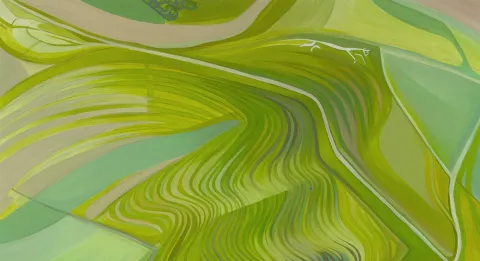Not surprisingly a place as evocative as White Horse Hill, and an image as distinctive as the White Horse itself, have attracted the attention of writers and artists.
It is difficult now to appreciate the popularity of G. K. Chesterton (1874 – 1936) in Edwardian England. Many consider The Ballad of the White Horse to be his finest work – an epic poem romanticising the feats of King Alfred. Chesterton got round the dating argument by having Alfred clean the Horse, which already existed.
"For the White Horse knew England
When there was none to know"
Alfred reminds his people to ‘keep the White Horse white’ - a symbol of the health of the nation. A symbol of care and not, as can be claimed in these less innocent times, one with racial implications.
The White Horse did not only inspire romantic patriots like Chesterton. It also attracted modernist artists, who appreciated the austere simplicity of the chalk downland: poets such as Edward Thomas (a victim of World War I on the chalklands of France) and painters such as Paul Nash, the World War I artist who portrayed "Grey-hallowed hills crowned by old trees, haunted by Old Gods long forgotten. A landscape wonderful to think on".
In the 1930s and 1940s artists flocked around the Uffington home of the Poet Laureate John Betjeman and his wife Penelope. Mrs Betjeman danced on the eye of the White Horse to improve her chances of a pregnancy. In 1939 Eric Ravilious created what is perhaps the most famous painting of White Horse Hill; he was later described as the consummate artist of the "cold pastoral of the chalk" by the critic Cyril Connoly when describing an exhibition of Shell posters by distinguished artists.
In 1977 Rosemary Sutcliff published an excellent children’s book (also recommended for adults), Sun Horse, Moon Horse, telling a compelling story of the creation of an Iron Age Horse.
At the 2003 launch of our publication of the White Horse Project, in a packed Uffington Village Hall, the poet and author, Jon Stallworthy, read his new poem Skyhorse, in which he paints White Horse Hill as an English Parnassos, the home of the muses and Apollo. It deserves to be better known.
In more recent years artists from many countries and in many styles have been inspired by the White Horse country. The most local and dedicated is Anna Dillon, whose colourful and vibrant images are very far from the "cold pastoral". Anna kindly agreed to have two of her beautiful paintings accompany this concluding chapter of our history and story of the White Horse.
The White Horse continues to mean many things to many people. It appears on the cover of punk records, on the sides of plumbers’ vans. It is the image of the local authority, the Area of Outstanding Natural Beauty, of local schools and breweries. Enthusiasts have the horse image tattooed on their bodies.
As Bill Bryson indicated: we continue to like it. Splendid!


